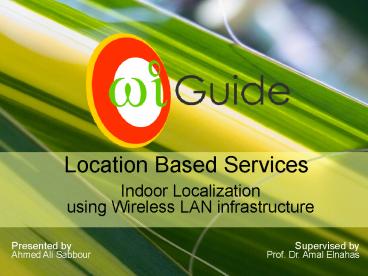Indoor Localization PowerPoint PPT Presentation
Title: Indoor Localization
1
Location Based Services
Indoor Localization using Wireless LAN
infrastructure
Supervised byProf. Dr. Amal Elnahas
Presented byAhmed Ali Sabbour
2
Location based services
- Make use of geospatial location information
- Provide users with emergency, information,
tracking and entertainment services.
3
Motivation
- Previous systems focused on outdoors
- GPS not suitable for indoor localization
- Indoor systems used sensor networks
- Using WLAN infrastructure
4
Aim of the project
- Design a system to locate users indoors
- Provide location sensitive information
- Can be used on campus and in museums
5
Approach
System based on fingerprinting approach
Phase 1
Training
Phase 2
Matching
challenges..
6
Signal instability
Challenges
7
Granularity
Challenges
8
Number of access points
Challenges
9
Number of samples
Challenges
10
User orientation
Challenges
11
Goals
- Server able to handle multiple clients
- Thin client for deployment on small devices
- Creating a fingerprinting training algorithm
- Creating a location matching algorithm
12
System design
requestandresponse
13
Algorithms
- Training
- Fingerprinting algorithm
- Matching
- Range based algorithm
- Euclidean distance based algorithm
14
Fingerprinting algorithm
DetermineGroup Leader
15
Determine Group Leader
Start
Sort Readingsby Frequency Descending
50
, 47
Get FirstReading
PossibleLeaders
add to
current freq previous?
Get NextReading
Yes, add to
No
Leader is mean ofpossible leaders
16
Fingerprinting algorithm
(49)?
CalculateLeadersRange
(47 to 50)?
17
Fingerprinting algorithm
(49)?
(47 to 50)?
CalculateFilteredRange
18
Calculate Filtered Range
ThresholdIf we take it as 50
Minimum frequencyFreq(Leader) x Threshold
Freq(49) x 50 20 x 50 10 readings \Readings
with frequency lt 10 will not be considered.
19
Calculate Filtered Range
Filtered Standard Deviation The SD of all
readings above the minimum frequency
(10).Filtered SD 1.98 instead of 6.18
Filtered Range The leaders range filtered SD.
Why filtered standard deviation?
20
Fingerprinting algorithm
Store room, mac address, filtered range
low, filtered range high, leader
(49)?
moregroups?
(47 to 50)?
for the 3 mostcommon access points
CalculateFilteredRange
(45 to 52)?
21
Matching algorithmClient side
ltreply valid1gt ltroom id23 x50
y23gt ltnamegtStudent classlt/namegt ltnumgt301lt/n
umgt ltbuildinggtB2lt/buildinggt lt/roomgtlt/replygt
Start
Take Reading
30 times
For EachGroup
Group byMAC address
DisplayLocation
DetermineGroup Leader
Yes
ltmessagegt ltgroupgt ltmacgt0030BDF25F32lt/
macgt ltsignalgt52lt/signalgt lt/groupgt
ltgroupgt ltmacgt00AF28911235lt/macgt
ltsignalgt45lt/signalgt lt/groupgtlt/messagegt
Parse responseXML message
moregroups?
Sendto Server
Server sideMatching
ConstructXML messagewithGroup Leaders
No
22
Matching algorithmServer side
Parse XML message received from client and from
the MAC addresses and signal strengths, form an
Observed Signal Vector
- Two algorithms
- Range based algorithm
- Euclidean distance based algorithm
23
Matching algorithmRange based
- For simplicity, assume
- Only 2 reference points per room
- Only 1 access point per reference point
A search for a room, given the observed signal
vector MAC A7C8, Signal 37
Room 1 is more likely to be the correct location.
24
Matching algorithmEuclidean distance based
n represents the number of access points recorded
for each reference point, o is the observed
signal value ands is a stored signal value in
the database.
For simplicity of the example, let n 1, which
means that only 1 access point is recorded for
each reference point.
25
Matching algorithmEuclidean distance based
A search for a room, given the observed signal
vector MAC A7C8, Signal 37
Room 1 with reference point 2 is more likely to
be the correct location, because it has
the minimal Euclidean distance from the observed
signal vector.
26
Matching algorithmServer side
- Server then constructs an XML message with
- Detected room
- Coordinates
- and sends message to the client.
27
Accessing information
The client then opens an HTTP connection to the
webserver http//webserver/location.php?roomltid
gt
The server then constructs an HTML page using PHP
with information regarding the location.
28
Results
- The system is able to detect user's location
correctly within 3-4 meters accuracy - 70 of the time, using Euclidean based
- 60 of the time, using range based
29
(No Transcript)
30
(No Transcript)
31
- Thank you.

